Coyote: 3-year-old pounced on by coyote, wild animal also threatens family dog
While most evening-time dog walkers certainly need to be careful for a chance encounter with a wild animal like a coyote, these confrontations are usually uncommon occurrences. Yet for a 3-year-old girl and her family, the infrequent happened at the local Irvine intersection of Silverado and Equinox. A mother and her two young daughters were out for an after-dinner walk with their pet dog at roughly 6 pm on Friday when they heard a rustling nearby.
There was little time to react before the threatening thing pounced. The mother said that as one of her children went to pick up some dog waste with a small paper baggy, a coyote suddenly emerged from some nearby shrubbery. It leapt on top of her and appeared to bite her neck. According to Lieutenant Kent Smirl of the California Department of Fish and Wildlife, the mother and several other passerby sprang into action, scaring the wild animal away before it could cause serious harm.
KTLA News added this evening the 3-year-old coyote attack victim should count herself very lucky. Although she suffered some bad bruising from the attack and falling to the pavement, her skin was not punctured in the incident. Medical officials on the scene determined she had not been bitten, and it was thus unnecessary for the child to receive any shots for rabies. The young girl was still taken to a nearby hospital, but she was released within the hour.
-------------------------------------------------------------------------------------------------------
-------------------------------------------------------------------------------------------------------
Coyote “Attacks” and the Media, OR “Messaging”
in coexisting with coyotes, coyote "attacks", coyote "messaging" behavior, coyotes and dogs, coyotes defending themselves, dog reactions to coyotes Tags: coyote "messaging" behavior, coyote attacks, coyotes and dogs, sensationalist media
The following news item and video (click on the link) serve as a departure point for exposing the truth about most reported “attacks” by coyotes, and for explaining coyote “messaging”: “Caught On Camera: Dog Attacked By Coyote”.
Although the video purports to show an “attack”, it does not do so. By calling this an “attack”, the article is creating a news story through sensationalist hype and playing on people’s fears. It sells well, it’s exciting, and it raises the fear level to a frenzy that, for most folks, justifies killing coyotes. It is irresponsible journalism, but it is how the press has been handling almost all reports regarding coyotes. We have suggested to journalists and news stations that they please contact biologists trained specifically in coyote behavior to help them get correct information out to the public, and this article does at least list what folks can do when they see a coyote. At the same time it calls what happened an “attack” which is blatantly incorrect.
What the video does show is a few seconds of a dog running from a coyote chasing it. Also, the article reports a couple of sightings, and that the dog, Lexus, came home with a few scratches. These are the facts from which this “attack” article is spun. But the dog wasn’t maimed, he wasn’t hurt, and there’s no proof at all that he was “attacked”. That he “got away with his life” is pure fabrication and sensationalistic.
If anything at all, the dog was simply “messaged” to stay away for intruding or even chasing the coyote. That’s it.
I’ve been photo-documenting urban coyote behaviors, including their interactions with humans and pets, in urban parks for eight years. I have only seen coyotes chase dogs in the manner shown in the news video clip, when a dog has gone chasing after the coyote first, or when the dog has intruded on the coyote in some way and then decided to run off. Dogs are constantly intruding on coyotes. A coyote’s nipping message is their attempt to drive the dog away, not maul him to death. It’s how they protect their territories or dens and it’s how they drive intruder coyotes away.
This series of 17 slides shows what happens when coyotes and larger dogs engage. When a coyote approaches a dog, it does so by making quick, short charges and quick retreats, where it is always ready to run off if the dog faces it. Coyotes aren’t animals who will take chances of being injured, so they avoid all-out fights with dogs. Please remember that running away by any animal raises a coyote’s adrenaline and incites a coyote to chase. We advise people never to run from a coyote for this reason.
For more information on dog encounters, see video presentation, “Coyotes As Neighbors” and posting of March 30th: Pupping Season: What Behaviors to Expect If You Have A Dog, and What You Can Do,.
-----------------------------------------------------------------------------------------------------------
Although the video purports to show an “attack”, it does not do so. By calling this an “attack”, the article is creating a news story through sensationalist hype and playing on people’s fears. It sells well, it’s exciting, and it raises the fear level to a frenzy that, for most folks, justifies killing coyotes. It is irresponsible journalism, but it is how the press has been handling almost all reports regarding coyotes. We have suggested to journalists and news stations that they please contact biologists trained specifically in coyote behavior to help them get correct information out to the public, and this article does at least list what folks can do when they see a coyote. At the same time it calls what happened an “attack” which is blatantly incorrect.
What the video does show is a few seconds of a dog running from a coyote chasing it. Also, the article reports a couple of sightings, and that the dog, Lexus, came home with a few scratches. These are the facts from which this “attack” article is spun. But the dog wasn’t maimed, he wasn’t hurt, and there’s no proof at all that he was “attacked”. That he “got away with his life” is pure fabrication and sensationalistic.
If anything at all, the dog was simply “messaged” to stay away for intruding or even chasing the coyote. That’s it.
I’ve been photo-documenting urban coyote behaviors, including their interactions with humans and pets, in urban parks for eight years. I have only seen coyotes chase dogs in the manner shown in the news video clip, when a dog has gone chasing after the coyote first, or when the dog has intruded on the coyote in some way and then decided to run off. Dogs are constantly intruding on coyotes. A coyote’s nipping message is their attempt to drive the dog away, not maul him to death. It’s how they protect their territories or dens and it’s how they drive intruder coyotes away.
This series of 17 slides shows what happens when coyotes and larger dogs engage. When a coyote approaches a dog, it does so by making quick, short charges and quick retreats, where it is always ready to run off if the dog faces it. Coyotes aren’t animals who will take chances of being injured, so they avoid all-out fights with dogs. Please remember that running away by any animal raises a coyote’s adrenaline and incites a coyote to chase. We advise people never to run from a coyote for this reason.
For more information on dog encounters, see video presentation, “Coyotes As Neighbors” and posting of March 30th: Pupping Season: What Behaviors to Expect If You Have A Dog, and What You Can Do,.
-----------------------------------------------------------------------------------------------------------
Pupping Season: What Behaviors to Expect If You Have A Dog, and What You Can Do
in coexisting with coyotes, coyote behavior Tags: coyote behaviors during pupping season, coyote pupping season, dog-coyote interactions during pupping season
Coyote pupping season is in full swing, which is obvious from coyote behaviors I’m now observing in our parks. Since mating occurred through mid-February and, now that it is mid-March, dens are being selected and dug. In preparation for the big event, all coyotes, especially males, are vigilantly contributing their share to the process: they are safeguarding their family territories to help make them safe for pups. Where does this come from?
We all need to become aware of coyote behaviors so that we can know how to prevent issues. Coyotes don’t like canine intruders in their territories: they even don’t allow non-family coyotes in. All canines, be they wolves, dogs, foxes or coyotes, don’t really like each other and all will exclude the others, as well as members of their same species who are non-family members, from their territories. This is instinctive behavior. We can’t really change their instincts for survival, but we can learn about them and understand them, and modify our own behaviors, so that all of us — human, cat, dog, coyote — can coexist. The guidelines are few and simple.
- I came upon this fella sitting in MY observation post — he was messaging me to move on. So I did.
- Seeing this dog, two coyotes ran in its direction. The walker didn’t leash his dog until I yelled that coyotes were out. Facing the coyotes stopped the coyotes from following him.
What behaviors might you see at this time?
1) Coyotes want you and your dog to know they are around so that you’ll know that the area has been taken and is not up for grabs. One way of letting us know this is being more conspicuous. Increased visibility is a “message” to everyone and it’s a pretty basic way of letting us know they are around.
2) Coyotes also may actually approach dogs to get them to “move on” or “go away.” As you are walking along, a coyote could hurry in your dog’s direction and could even try to sneak up from behind in an attempt to give your dog a little nip or pinch on the hind quarters. Remember that they are approaching your dog, not you. They could try to do this when you aren’t looking at them, even if your dog is leashed. Their aim is not to maim, but to firmly “message” your dog to leave. A small abrasion or scratch may result. You can prevent this.
- An unleashed dog has charged in to chase coyotes
- This is a nip to the behind that coyotes use to “message” their needs to be left alone. Coyotes avoid all-out “attacks” because they won’t take risks that might jeopardize their own safety.
What you need to do during this season is:
1) Be aware, alert and vigilant as you walk your dog during this pupping period. If you see a coyote, even if it’s out in the distance, make sure your dog is on a short leash and continue walking on and away from the coyote. Nonetheless, the coyote, or coyotes, could hurry in your and your dog’s direction — they have a job to do which is instinctive: know what is happening and be prepared.
2) If and when a coyote has come within 30-50 feet — just stop and face the coyote eyeball to eyeball — usually this is all you’ll have to do for the coyote to move on. If the coyote remains there, step in his direction and clap your hands or toss a small stone in his direction (not at him so as not to injure him), if the coyote moves, continue on your way, keeping an eye on him and without running. If he makes a second attempt, do this again with a little more energy. He’ll run off, and you, too, should walk on out of the area.
[For more information on coexisting between people, pets and coyotes, see“Coyotes As Neighbors”, a one-stop video presentation, created by Janet Kessler based on her photo-documentation of coyotes in urban parks].
- Coyote approaching and following a dog and walker: be prepared for their need to “message.”
- Stopping, facing the coyote eyeball to eyeball, stepping in its direction and clapping will get it to move away

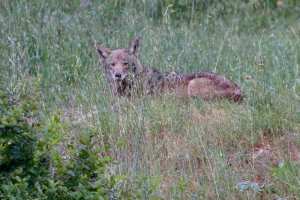
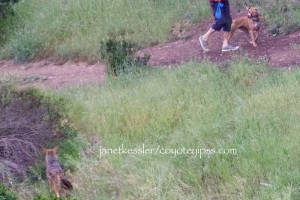
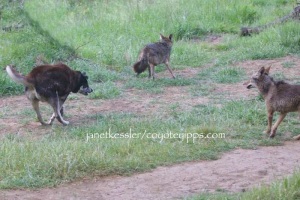
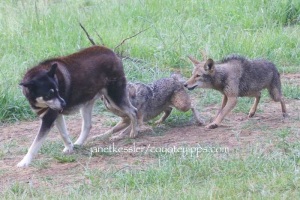
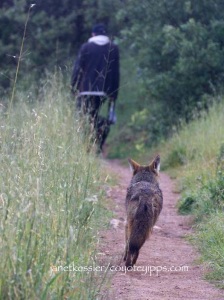
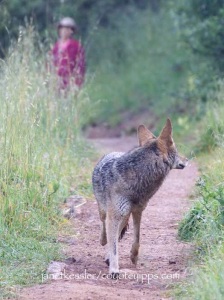









No comments:
Post a Comment